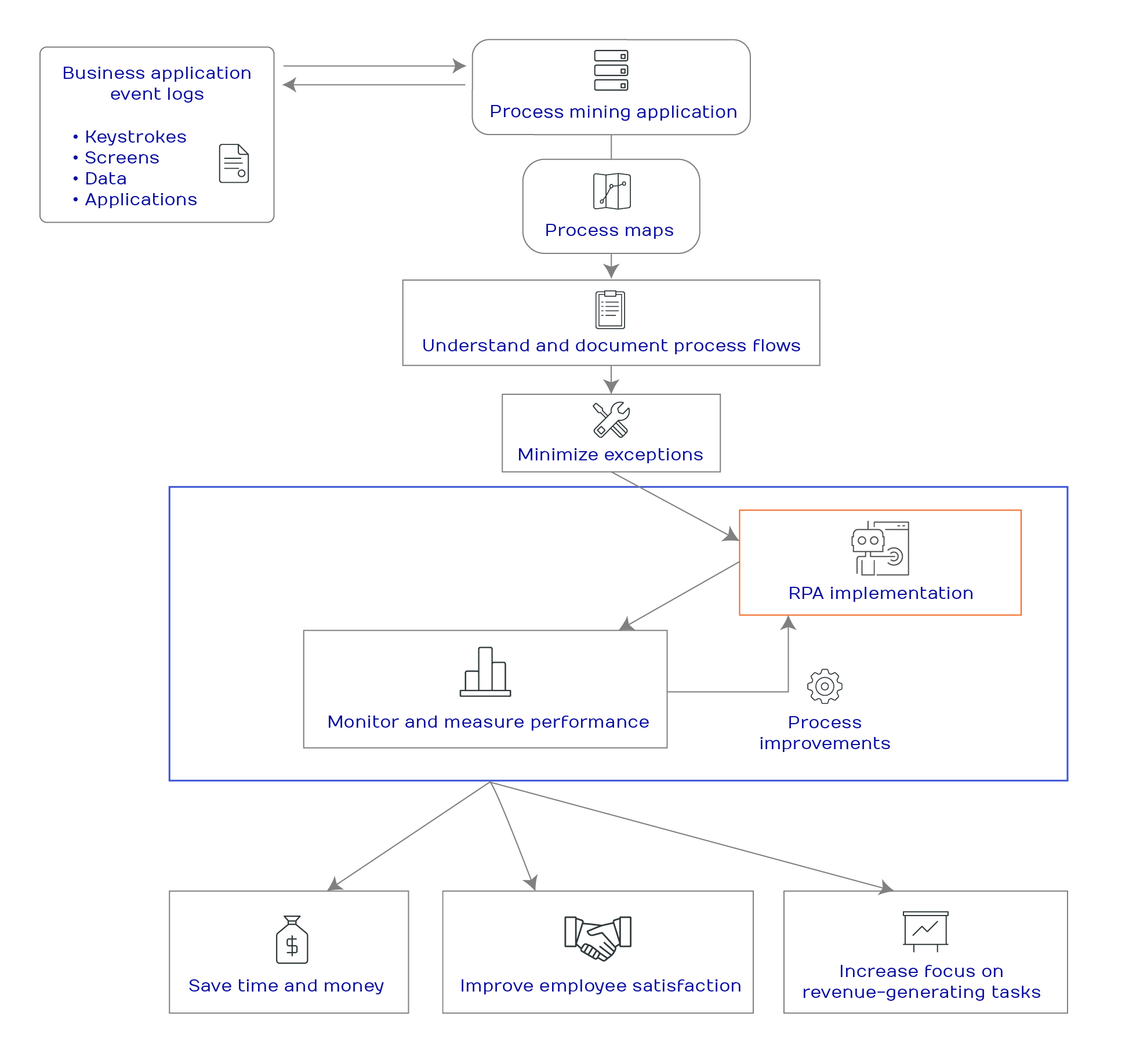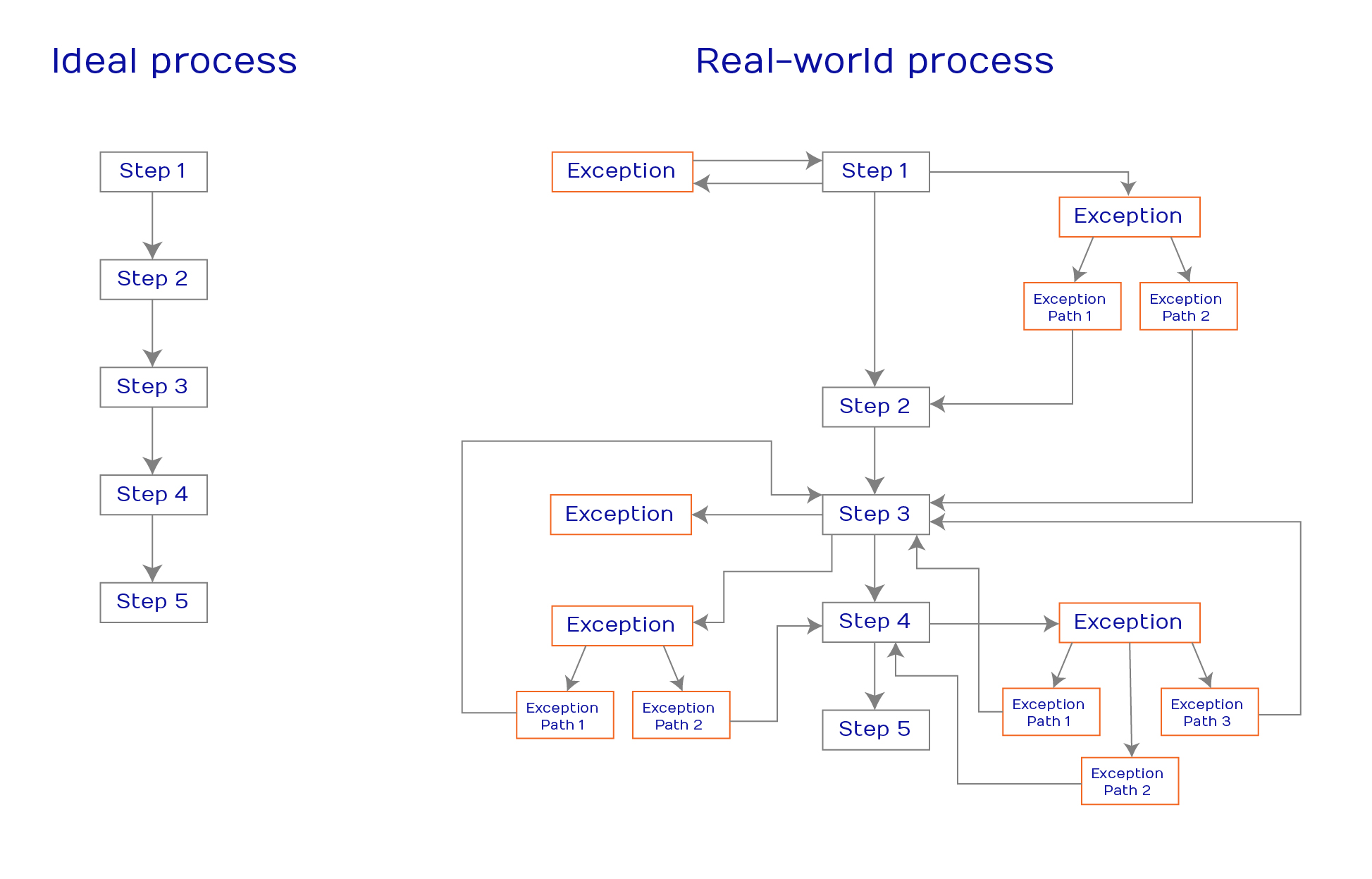As robotic process automation (RPA) continues to attract attention for its cost-saving and productivity-boosting benefits, more organizations are realizing that RPA implementation is one part of a larger automation journey. To gain the process intelligence needed for successful automation, present and future, businesses need the data-driven insights that process mining technology can deliver.
RPA + process mining = a winning combination
RPA delivers business value by automating specific processes, particularly those that involve disparate systems, as they are currently performed by humans. However, as some organizations have discovered, robotic process automation is not a “silver bullet” that will solve all process-related challenges. Simple RPA on its own cannot, for example:
- Fix broken processes
- Self-correct inefficiencies or errors
- Identify the best processes to automate
- Manage process variations
Process mining helps fill these gaps by delivering the real-world insights organizations need for successful RPA implementation, enabling organizations to understand process flows, minimize exceptions, and monitor performance:

Automation platform providers are recognizing the value of these insights and making significant investments in process flow technologies. Microsoft, for example, has expanded its Power Automate platform to include a UI flow feature, which allows the software to track and develop process flows to accelerate the path to automation.
What is process mining?
Before a process can be successfully automated, it must first be understood. While interviewing subject-matter experts can give you a good idea of how a process should execute, discovering what actually happens when it does execute, including the standard path as well as variations, requires some technical muscle. Enter process mining.
As users work on a system, every action is automatically entered in the system’s event logs. Process mining applications capture these “digital footprints” and present the data in a way that shows the actual process flow as well as any deviations from the standard/optimal path. Some tools, like UiPath’s Task Mining, dig even deeper to explore how individual tasks within the process are executed and to offer insights on how each action affects business outcomes.
By painting a clear picture of how the process executes, process mining delivers vital information to support the RPA implementation process and shorten the overall time-to-automation window.
3 ways process mining accelerates RPA
Robotic process automation offers businesses the opportunity to reduce costs, improve productivity, and heighten employee satisfaction by assigning repetitive tasks to digital workers. By mapping real-world process flows before and after RPA implementation, process mining enables data-driven decision making around where the opportunities lie and how to maximize return on investment.
For the purposes of this article, we’ll use a single example, customer account lookup at a call center, to illustrate the ways in which process mining supports and enhances RPA implementation.
1. Understanding process flows
Implementing RPA without first understanding how the process works in real life could be a recipe for frustration or failure. Process mining uses data from event logs to map out actual process flows from beginning to end, including variations, to support identification of candidates for automation, pre-automation streamlining and elimination of bottlenecks, and planning for exception cases. The organization then has the insights it needs to choose the best candidates for RPA and accelerate time-to-automation.
Example: A process mining application maps out an end-to-end process flow for client account lookups using event logs from the call center system. The application analyzes every agent’s keystrokes, clicks, and other variables to
- Show each step in the process
- Calculate the time and effort each phase requires
- Show the percentage of total cases for each variation
This analysis presents an accurate view of the process that can serve as the basis for an automation strategy.
2. Minimizing exceptions
In a perfect world, organizations would be able to point to a process and describe how it works every time with 100 percent confidence; in reality, this is rarely the case. As employees execute processes repeatedly, pockets of “tribal knowledge” emerge, resulting in the same process being performed in any number of different ways by different individuals. As processes become less standardized, analytics become less accurate, making the process more difficult to document.
In any business process, some exceptions are inevitable, while others result from insufficient training, inability to access the required data, or other avoidable problems. Some process flows may display “rebounds” — situations in which an issue bounces back and forth between steps and between teams. In addition to being costly, rebounds can add significant complications in the path to automation.
The more deviations and exceptions a process has, the more complex and tedious it will be to implement RPA. Process mining shows the paths for all variations, their root causes, the percentage of total cases they account for, and the time required, delivering the data needed to identify an optimal path and consolidate the number of exceptions.

Example: One call center agent may look customers up by account number, while another may use name and address. This can result in duplicate or inaccurate records being created as well as increased call times, which can frustrate customers. Process mining can analyze variations from the optimal account-lookup process flow, enabling the organization to standardize the process and minimize the number of exceptions its RPA platform will have to accommodate.
3. Continuous performance improvement
Process mining lets you monitor the performance of your digital workforce 24/7 to help you address errors and enable continuous process improvement. Using your present-state process flows as a benchmark, process mining can measure per-activity costs and help you determine how RPA is benefiting your organization.

Examples of process mining dashboards from Celonis (left) and ProcessGold (right)
Example: After implementing RPA for customer account lookups, the call center can leverage process mining in comparing post-implementation results with the original benchmark to identify time savings. If automating the process shortens every call by an average of, say, one to two minutes, the total amount of time saved could add up to significant cost savings for the organization, in addition to freeing call center agents to focus their time and efforts on nurturing customer relationships.
We are still in the early stages of integration between these two technologies, in which process mining enables organizations to achieve robotic process automation more efficiently. I see this development as a starting point on a path towards truly intelligent RPA, in which digital workers will leverage process mining and machine learning to become self-teaching, self-monitoring, and self-optimizing. We’re not quite there yet, but for now, organizations can leverage process mining’s valuable insights to give their RPA programs the greatest chance of success.
Like what you see?

Amit Unadkat is a Manager of Digital Transformation with extensive experience in robotic process automation, virtual assistants, business process optimization, and technical product management.

